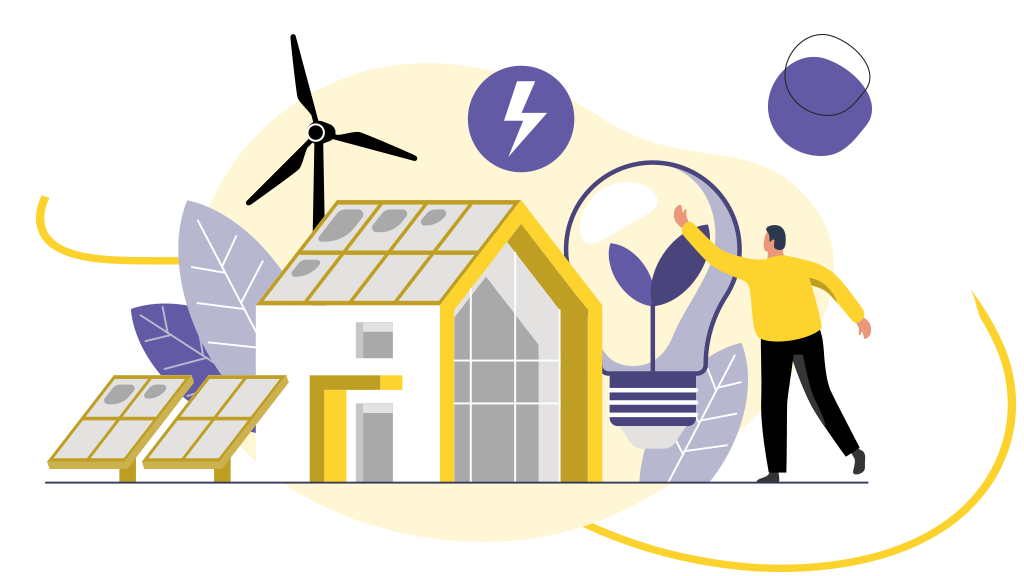Whether you’ve been here for years or days, the life of an immigrant is not easy, especially when it comes to money. Uncle Sam’s land is great, but it comes at a cost. And when expenses start to pile up, we all know how helpful it can be to find new ways to save money.
One of the best ways to reduce your monthly bills is to invest in renewable energy. This can often be done with systems you can build yourself.
Using renewable energy to power your home can reduce or completely eliminate your utility bills, and there are tax breaks for installing renewable energy that can make it even more cost-effective. On the plus side, by becoming more independent about your energy supply and breakdown, you are helping to protect our planet.
To learn more about government incentives for installing removable energy systems, visit
Dsire’s website.
Planning for home renewable energy systems
The US Department of Energy provides a complete guide to help you plan your home renewable energy system. We want to share right from the source as it is truly all-inclusive, so we are sharing the guide below to help make the information more accessible to our readers. You can read the text in its entirety from the source here.
Planning for a home renewable energy system is a process that includes analyzing your existing electricity use, looking at local codes and requirements, deciding if you want to operate your system on or off of the electric grid, and understanding technology options you have for your site.
Maybe you are considering purchasing a renewable energy system to generate electricity at your home. Although it takes time and money to research, buy, and maintain a system, many people enjoy the independence they gain and the knowledge that their actions are helping the environment.
A renewable energy system can be used to supply some or all of your electricity needs, using technologies like:
- Small solar electric systems
- Small wind electric systems
- Microhydropower systems
- Small hybrid electric systems (solar and wind).
Planning for a home renewable energy system is a process that includes analyzing your existing electricity use (and considering energy efficiency measures to reduce it), looking at local codes and requirements, deciding if you want to operate your system on or off of the electric grid, and understanding technology options you have for your site.
If you’re designing a new home, work with the builder and your contractor to incorporate your small renewable energy system into your whole-house design, an approach for building an energy-efficient home.
Analyzing Your Electricity Loads
Calculating your electricity needs is the first step in the process of investigating renewable energy systems for your home or small business. A thorough examination of your electricity needs helps you determine the following:
- The size (and therefore, cost) of the system you will need
- How your energy needs fluctuate throughout the day and over the year
- Measures you can take to reduce your electricity use.
Conducting a load analysis involves recording the wattage and average daily use of all of the electrical devices that are plugged into your central power source such as refrigerators, lights, televisions, and power tools. Some loads, like your refrigerator, use electricity all the time, while others, like power tools, use electricity intermittently. Loads that use electricity intermittently are often referred to as selectable loads. If you are willing to use your selectable loads only when you have extra power available, you may be able to install a smaller renewable energy system.
To determine your total electricity consumption:
- Multiply the wattage of each appliance by the number of hours it is used each day (be sure to take seasonal variations into account). Some appliances do not give the wattage, so you may have to calculate the wattage by multiplying the amperes times the volts. Generally, power use data can be found on a sticker, metal plate, or cord attached to the appliance.
- Record the time(s) of day the load runs for all selectable loads.
Considering energy efficiency measures in your home before you buy your renewable energy system will reduce your electricity use and allow you to buy a smaller and less expensive system. For information about determining the overall energy efficiency of your home, see energy assessments.
Local Codes and Requirements for Small Renewable Energy Systems
Each state and community has its own set of codes and regulations that you will need to follow to add a small renewable energy system to your home or small business. These regulations can affect the type of renewable energy system you are allowed to install and who installs it. They can also affect whether you decide to connect your system to the electricity grid or use it in place of grid-supplied electricity as a stand-alone system.
A local renewable energy company or organization, your state energy office, or your local officials should be able to tell you about the requirements that apply in your community. If you want to connect your system to the electricity grid, these groups may also be able to help you navigate your power provider’s grid-connection requirements. Here are some of the state and community requirements you may encounter:
- Building codes
- Easements
- Local covenants and ordinances
- Technology-specific requirements
Electrical and building inspectors ensure that your system complies with standards. Building inspectors are interested in making sure the structure you are adding is safe. Your system may be required to pass electrical and/or plumbing inspections to comply with local building codes.
Many building code offices also require their zoning board to grant you a conditional-use permit or a variance from the existing code before they will issue you a building permit. Check with your building code office before you buy a renewable energy system to learn about their specific inspection requirements.
You are most likely to gain the inspector’s approval if you or your installer follow the National Electrical Code (NEC); install pre-engineered, packaged systems; properly brief the inspector on your installation; and include a complete set of plans as well as the diagrams that come with the system. In addition, you should be sure your system is composed of certified equipment, and that it complies with local requirements and appropriate technical standards (the links at the bottom of the page provide more information on technical standards).
Easements
Some states permit easements, which are a voluntary, legally binding agreement between owners of adjacent land regarding use of the land. For example, you might seek an easement specifying that no structure which blocks the renewable resource necessary to run a renewable energy system will be built. These agreements are binding regardless of changing land ownership. In addition, you may want to do a title search of your deed to determine if any prior easements or other agreements exist that could prevent you from adding a renewable energy system to your own property.
Local Covenants and Ordinances
Some communities have covenants or other regulations specifying what homeowners can and can’t do with their property. Sometimes these regulations prohibit the use of renewable energy systems for aesthetic or noise-control reasons. However, sometimes these regulations have provisions supporting renewable energy systems. Check with your homeowners association or local government for details. In addition, you may want to discuss your intentions with your neighbors to avoid any future public objections.
Grid-Connected or Stand-Alone System
Some people connect their systems to the grid and use them to reduce the amount of conventional power supplied to them through the grid. A grid-connected system allows you to sell any excess power you produce back to your power provider.
For grid-connected systems, aside from the major small renewable energy system components, you will need to purchase some additional equipment (called “balance-of-system”) to safely transmit electricity to your loads and comply with your power provider’s grid-connection requirements. This equipment may include power conditioning equipment, safety equipment, and meters and instrumentation.
Other people, especially those in remote areas, use the electricity from their systems in place of electricity supplied to them by power providers (i.e., electric utilities). These are called stand-alone (off-grid) systems.
For stand-alone systems, balance-of-system components include batteries and a charge controller in addition to power conditioning equipment, safety equipment, and meters and instrumentation.
Choosing the Right Renewable Energy Technology
To begin choosing the right small renewable electric system for your home, you will need a basic understanding of how each technology works, as well as:
- Renewable energy resource availability
- Economics and costs
- System siting
- System sizing
- Codes and regulations
- Installation and maintenance considerations.
Remember that all of these technologies can be used by themselves, combined, or used in conjunction with a fossil fuel system. When these technologies are combined or used with a fossil fuel generator, the result is a hybrid system.
Technology options include solar, wind, microhydropower, and hybrid electric systems (solar and wind).
- Small solar electric systems — A small solar electric or photovoltaic system can be a reliable and pollution-free producer of electricity for your home or office. Small photovoltaics systems also provide a cost-effective power supply in locations where it is expensive or impossible to send electricity through conventional power lines.
- Small wind electric systems — Small wind electric systems are one of the most cost-effective home-based renewable energy systems. They can also be used for a variety of other applications, including water pumping on farms and ranches.
- Microhydropower systems — Microhydropower systems usually generate up to 100 kilowatts of electricity, though a 10-kilowatt system can generally provide enough power for a large home, small resort, or a hobby farm.
- Small “hybrid” solar and wind electric systems — Because the peak operating times for wind and solar systems occur at different times of the day and year, hybrid systems are more likely to produce power when you need it.
Source: US Department of Energy
You can expect to hear a lot about renewable energy in the coming years. We must prioritize the quest to reduce our impact on this little blue planet, and making changes to how we source our energy can make a massive difference.
Stay tuned for more articles on this topic!








